Green And Clean The Wind Energy
|
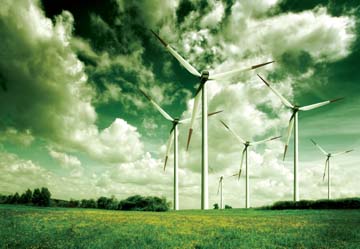
|
The total potential for wind power in India was first estimated by the Centre for Wind Energy Technology at 45 GW, and was recently increased to 48.5 GW. With larger turbines, greater land availability and expanded resource exploration, the potential
could be as high as 100 GW. |
Wind Energy is an indirect form of Solar Energy. About 1 % of the total solar radiation that reaches earth is converted into wind energy. Wind results from differential heating of the earth and its atmosphere by sun. As the sun heats different parts of the earth at different rates, air circulates from cold to warm areas producing wind. Wind energy has been used for thousands of years to propel sailing ships, small ferries, pumping water and even grinding grain.
With the availability of ample wind power, India can be one of the exemplar for other countries in this endeavour. But in the past few decades, with the increase in population, the issue of scarcity of natural resources is addressed globally by the intervention of the government. It has implemented eco-friendly norms in the country to reduce the consequence of global warming. So, with these stringent norms and incentive scheme, no doubt wind energy can go a long way in beefing up the nation's effort in securing a sustainable future for India. On the other hand, considering that India is still a developing nation, there are many obstacles for wind energy sector, the main hindrance being that many areas are not windy. The states like Tamil Nadu and Gujarat lead in the wind energy sector.
On the global level, wind energy capacity is growing rapidly on a larger scale as many countries are taking initiatives to work towards renewable energy. The top countries which are promoting wind energy are Denmark, United States, Spain and Germany. With people using wind turbine-generated electricity, it has gained a maximum momentum reaching to a double digit number all over the world. Denmark is the leading country, which has successfully shown a raising graph and has been an exemplar to other countries.
In India, the states with highest wind power concentration are Tamil Nadu, Maharashtra, Gujarat, Rajasthan, Karnataka, Madhya Pradesh and Andhra Pradesh. The Indian market is expanding with the leading wind companies like Suzlon, Vestas, Enercon, RRB Energy and GE.
The wind power program was initiated in 1983-84 by the Government of India. A data has been created which includes resource assessment, research and development, creation of awareness and development of infrastructure facilities for manufacturing and also provided policy support. It was estimated by the Government of India that there is a potential of 45,000 MW wind power in the country and so far 11,807 MW has been tapped as on March 31, 2010.
Indian Wind Energy Association has estimated that with the current level of technology, the ‘on-shore' potential for utilization of wind energy for electricity generation is of the order of 65,000 MW. The unexploited resource availability has the potential to sustain the growth of wind energy sector in India in the years to come.
According to Indian Wind Energy Association (IWEA) the Indian wind energy sector has an installed capacity of 14158.00 MW (as on March 31, 2011). In terms of wind power installed capacity, India is ranked 5th in the World. Today India is a major player in the global wind energy market.
The potential is far from exhausted. Indian Wind Energy Association has estimated that with the current level of technology, the ‘on-shore' potential for utilization of wind energy for electricity generation is of the order of 65,000 MW. The unexploited resource availability has the potential to sustain the growth of wind energy sector in India in the years to come.
The Wind power program in India was initiated towards the end of the Sixth Plan, in 1983-84. A market-oriented strategy was adopted from inception, which has led to the successful commercial development of the technology. The broad based National program includes wind resource assessment activities; research and development support; implementation of demonstration projects to create awareness and opening up of new sites; involvement of utilities and industry; development of infrastructure capability and capacity for manufacture, installation, operation and maintenance of wind electric generators; and policy support. The program aims at catalyzing commercialisation of wind power generation in the country. The Wind Resources Assessment Program is being implemented through the State Nodal Agencies, Field Research Unit of Indian Institute of Tropical Meteorology (IITM-FRU) and Center for Wind Energy Technology (C-WET).
Wind in India are influenced by the strong south-west summer monsoon, which starts in May-June, when cool, humid air moves towards the land and the weaker north-east winter monsoon, which starts in October, when cool, dry air moves towards the ocean. During the period march to August, the winds are uniformly strong over the whole Indian Peninsula, except the eastern peninsular coast. Wind speeds during the period November to march are relatively weak, though higher winds are available during a part of the period on the Tamil Nadu coastline.
A notable feature of the Indian program has been the interest among private investors/developers in setting up of commercial wind power projects. The gross potential is 48,561 MW (source C-wet) and a total of about 14,158.00 MW of commercial projects have been established until March 31, 2011.
The break-up of projects implemented in prominent wind potential states (as on March 31, 2011) is as given below
| State-wise Wind Power Installed Capacity in India |
| State |
Gross Potential
(MW) |
Total Capacity (MW)
till 31st March 2011 |
| Andhra Pradesh |
8968 |
200.2 |
| Gujarat |
10,645 |
2175.6 |
| Karnataka |
11,531 |
1730.1 |
| Kerala |
1171 |
32.8 |
| Madhya Pradesh |
1019 |
275.5 |
| Maharastra |
4584 |
2310.7 |
| Orissa |
Orissa |
- |
| Rajasthan |
4858 |
1524.7 |
| Tamil Nadu |
5530 |
5904.4 |
| Others |
- |
4 |
| Total (All India) |
48,561 |
14,158 |
To give a broader view on wind energy, Built Constructions in an exclusive interview with one of leading wind power company ‘Suzlon' and also, Indian Wind Energy Association (InWEA) and World Institute of Sustainable Energy (WISE) who gave us the complete outlook of this sector and the future it holds on a global scale.
The Suzlon Group is ranked as the world's fifth largest wind turbine supplier, in terms of cumulative installed capacity, at the end of 2010. Established in 1995 and being headquartered in Pune, the company hold 8% of the world wind energy market share. The company's global spread extends across Asia, Australia, Europe, Africa and North & South America with over 19,000 MW of wind energy capacity installed in 28 countries, operations in 32 countries and a workforce of over 13,000.
On the other hand, InWEA was setup in 2002 as a non-profit organisation under the Societies Act. InWEA with more than 300 members is dedicated to promote and develop wind power in India. Since its inception InWEA has consistently worked towards removing barriers to wind power development and creation of an enabling regulatory and policy environment for investments in this sector.
 |
Today, the Indian market is emerging as one of the major manufacturing hubs for wind turbines in Asia. Currently, eighteen manufacturers
operate in this space having an annual production capacity of 10,000 MW. According to the World Institute of Sustainable Energy (WISE), the annual wind turbine manufacturing capacity in India is likely to exceed 17,000 MW by 2013.' |
The association is also a member of several national and international bodies such as the World Wind Energy Association, the European Wind Energy Association, Confederation of Indian Industry (CII), the Federation of Indian Chambers of Commerce and Industry and the Associated Chambers of Commerce and Industry of India (ASSOCHAM).
The World Institute of Sustainable Energy (WISE) is a not-for-profit, non government organization committed to promoting sustainable energy, energy conservation, and sustainable development, with a special emphasis on renewable energy. The activities of WISE thus aim to aid development of the renewable energy sector in all Indian states.
Indian Wind Energy Association (InWEA)
The market for wind energy has seen a constant growth in the last few years. What are the key factors that are driving this growth?
The growth of wind energy market is being driven by a number of factors, including the wider context of energy supply and demand, the rising profile of environmental issues, especially climate change, and the impressive improvements in the technology itself. These factors have combined in many regions of the world to encourage political support for the industry's development.
In India, a number of Policy initiatives at the Union government level have helped in taking the wind energy sector forward. The implementation of Renewable Portfolio Standard which requires every Indian state to procure a specific percentage of power from renewable energy-based power plants has given the market for wind energy a major boost.
In India, what is the estimated market in the wind turbine sector? Can you explain the growth of this segment over the years and future importance it holds in global eco-friendly scenario?
Today, the Indian market is emerging as one of the major manufacturing hubs for wind turbines in Asia. Currently, eighteen manufacturers operate in this space having an annual production capacity of 10,000 MW. According to the World Institute of Sustainable Energy (WISE), the annual wind turbine manufacturing capacity in India is likely to exceed 17,000 MW by 2013.
Some of the major players in the Indian wind turbine market are Suzlon, Vestas, Enercon, RRB Energy, GE, Gamesa, Siemens, and WinWinD. Of late, the Indian wind market has seen the entry of some new companies such as Sinovel (it has taken a Ghodawat Energy facility on lease to operate in India), Easywind GmbH, Gestamp Wind Steel and Windar Renovables - all vying to grab a share of the burgeoning Indian wind market.
The perception towards wind energy has changed in India compared to last few years, which in turn has attracted more wind turbines manufacturers to this market? Can you explain?
The favourable policy framework and regulations coupled with low manpower cost, raw material availability, and vast market potential have resulted in significant expansion of the market for wind turbines in the country. The presence of a number of WTG manufacturers ranging from international WTG manufacturers like Vestas, Enercon, GE, Goldwind, Sinovel etc. and emergence of domestic wind turbine manufacturers such as Suzlon and Bharat Heavy Electricals Ltd has also helped accelerate technological growth of the sector.
There is a common notion that wind turbine equipment is expensive, is it true. If not, how do you create awareness among people at large?
|
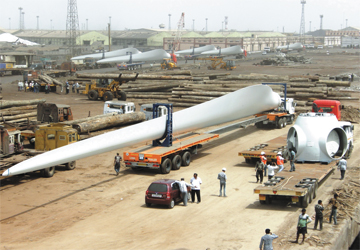
|
| Till the last financial year (2011-12) there were a number of incentives given by the Union government. However, with effect from March 2012, the Accelerated Depreciation benefit, which used to be the main driver behind wind energy growth in India, has been taken away. Another sop given to the wind sector, the Generation Based Incentive is likely to continue. |
Wind turbines are not very expensive. If we calculate all aspects of costs for any power generation equipment, wind is going to be the cheapest source of energy generation. In wind energy, only capital cost is high. The operation and maintenance costs are nominal.
Has the government been encouraging in promoting wind mills in terms of tax exemption/subsidies?
Till the last financial year (2011-12) there were a number of incentives given by the Union government. However, with effect from March 2012, the Accelerated Depreciation benefit, which used to be the main driver behind wind energy growth in India, has been taken away. Another sop given to the wind sector, the Generation Based Incentive is likely to continue. However, other benefits such as the REC mechanism, preferential tariff and income tax holidays on revenue from sale of wind power are there.
What initiatives or programmes has InWEA taken to encourage wind turbines / energy in India?
From time to time, InWEA engages in several critical issues affected the wind industry in India. It is an advisory body hence, it mediates between the industry players and regulatory commissions to resolve policy and regulatory matters. Over the years, the association has taken a number of initiatives to provide safe and conducive environment for wind power players to work in the country.
What are the advantages of generating wind energy compared to other conventional modes?
The benefits that wind energy offers in terms of power generation range from economic gains, Carbon Dioxide (CO2) emission reduction, and water conservation benefits. Besides, the resource proves to be cost-effective in the long-term. Most importantly, it adds to power supply to the grid.
What is the future of wind energy in a developing country like India?
After the re-assessment of wind power potential by the Centre for Wind Energy Technology (C-WET), India has emerged as one of the biggest markets in the world. Besides, a favourable policy condition supported by R&D and manufacturing facilities is sure to help the country have a great future in the wind energy sector.
As an association, what changes you want to see in the policies and regulations of the government in promoting renewable energy?
The need of the hour is uniform and stable policies that will help investors plan their ventures in the long run. Also, strong power evacuation infrastructure and a stable incentive mechanism would be good for the sector.
How can wind turbine generated electricity make a difference in combating climate change?
Wind power is a clean, renewable source of energy which does not produce greenhouse gas emissions or any other environmentally - hazardous waste. Conventional power stations are the biggest contributor to carbon emissions. We need to switch to forms of energy that do not produce CO2. Just one modern wind turbine of 1 MW has the capacity to save over 4,000 tonnes of CO2 emissions annually.
As an alternative energy, wind energy has great potential and can be used to a large extent. What is the impediment in generating it worldwide?
 |
The global wind installations reached to 238 GW by end of 2011, representing cumulative market growth of more than 20% which is respectable figure in this economic climate even though it is lower than the average over the last ten years which is about 28%. |
The world market for wind power has set a new record in the year 2011. The total capacity addition of wind power worldwide during the year was 41,236 MW and reached a cumulative capacity of 2,38,351 MW. A strong increase in wind power utilisation was observed especially in emerging markets like China, India, Brazil, and Mexico.
So, while wind energy use has been increasing rapidly across the world, the one impediment that it faces is its intermittent nature. However, a number of experiments are on to devise ways to store wind power in case of excess generation and use it later when there is no wind.
World Institute of Sustainable Energy
When did WISE start functioning? What are the major functions of WISE?
The World Institute of Sustainable Energy (WISE) is a not-for-profit, non-government organisation set up in June 2004 to promote sustainable energy, energy conservation, and sustainable development. In particular, the institute is committed towards addressing the shortcomings existing in the sustainable energy sector in India, viz. lack of policy support and incentives, lack of legislative and research support, lack of qualified manpower, and lack of critical awareness that would lead the transition to the sustainable energy-based economy.
The different centers and units of WISE functions independently, yet work cohesively in the true tradition of inter-disciplinary learning, team spirit, and knowledge sharing. WISE is the only institution in the country to possess such expertise most essential to propel the country towards sustainability in the 21st century.
More information on WISE can be obtained from website www.wisein.org
The market for wind energy has seen a constant growth in the last few years. What are the key factors that are driving this growth?
The global wind installations reached to 238 GW by end of 2011, representing cumulative market growth of more than 20% which is respectable figure in this economic climate even though it is lower than the average over the last ten years which is about 28%. China is the leader and have 62 GW installations followed by USA 47 GW, Germany 29 GW. India is on fifth rank with 17 GW installations. The key factors responsible for wind energy growth are:
a) Increase in fossil fuel price: The rise in fossil fuel prices compelled the countries to review their energy portfolio. Further, the adverse environmental impact of fossil fuels, volatility in their price and availability has compelled utilities and developers to explore alternatives for clean and sustainable fuel technologies. Hence, conventional power / energy companies are increasingly showing interest in RE installations.
b) Demand Supply Gap: The deficit power situation is driving the wind sector to have more projects with preferential feed-in tariff. Another reason is the shorter gestation period of wind projects, in comparison to the large thermal/ conventional projects.
c) Feed-in Tariff and RPS: Regulators have specified preferential tariff for procurement of RE by the distribution licensees and have also specified RPS. As a result, utilities are purchasing power from renewable energy sources for meeting the RPS obligation. Utilities found wind power a lucrative option to meet their RPS targets instead of paying hefty penalties in case of default.
With the present wind turbine manufacturing base inIndia, the future annual market we project to the tune of 5000 MW per annum by 2015.
d) Government Policies: To encourage energy generation from renewables, the government is announcing fiscal and financial benefits to generators in terms of tax concessions, generation-based incentive, preferential tariffs etc. Further, to increase the acceptability and tradability of renewable energy, government has introduced Renewable Energy Certificate (REC) mechanism.
e) Kyoto protocol and CDM: Clean Development Mechanism (CDM) under the Kyoto Protocol provides the required impetus for investment in low-carbon technologies, including renewable energy. Additional revenue by way of sale of certified emission reduction (CER) certificates generated from the CDM project enhances project viability. Well established methodology and procedure of registering under CDM have resulted in excellent track record in the recent past.
In India, what is the estimated market in the wind turbine sector? Can you explain the growth of this segment over the years and future importance it holds in global eco-friendly scenario?
The historical growth of the wind power sector in India can be grouped into three phases of development:
I. Period before 1994 & 95 (prior to initiation of MNRE's structured policy programme) - In India, the rate of wind power capacity addition was very slow during 1986 to 1994, which ended with cumulative capacity addition of 115 MW by the end of FY 1993-94.
II. Era between 1995 and 2003 (MNRE policy programme and prior to Electricity Act, 2003) - Later the sector had seen the first boom cycle (1994 to 1996) due to the announcement of fiscal benefits (100% accelerated depreciation and sales tax exemptions) along with the pre-defined tariff of INR 2.25 per kWh for wind power. The sector experienced bust cycle (1997 to 1999) due to the withdrawal of sales tax benefits in most states and restructuring of the corporate tax structure. The sector again saw the second boom-bust cycle during 1999-2000 to 2002-03. The cumulative installed capacity of wind power projects reached 1,868 MW by the end of FY 2002-03.
III. Period after 2003 (post-Electricity Act, 2003) - The 'golden phase' in the development of wind power sector in India started after the enactment of Electricity Act 2003. This has also seen the third boom and bust cycle during this period. The boom in wind capacity addition during 2003 to 2007 was mainly due to the enactment of Electricity Act -2003, introduction of Textile Upgradation Fund (TUF) Scheme, National Electricity Policy and National Tariff Policy, the growing energy demand and attractive tariffs. The bust cycle started after 2007 mainly due to increasing project costs, increasing interest rates, regulatory issues. New policies and regulatory innovations like National Action Plan on Climate Change (NAPCC) wherein the dynamic RPS of 5% across the country effective from FY 2009-10 with 1% annual escalation till 2020 is mandated by the central government.
Though the wind energy potential estimated by government agency CWET is about 102 GW, it may be substantially higher taking into account of actual land availability for wind power projects in windy areas and at higher hub heights. With the present wind turbine manufacturing base in India, the future annual market we project to the tune of 5000 MW per annum by 2015.
Since wind energy sector comes under low carbon technology option, investment in wind power generation is complementary to the mission of climate mitigation.
The perception towards wind energy has changed in India compared to last few years, which in turn has attracted more wind turbines manufacturers to this market? Can you explain?
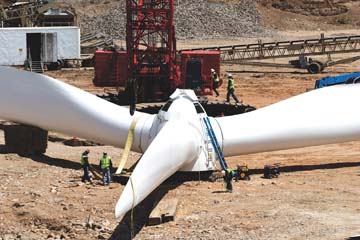 |
Recognising the huge domestic market potential in India as well as export potential, many new technical collaborations, joint venture projects, and subsidiaries of global players were announced in 2008 and 2009 for manufacturing and servicing of wind turbines. The market is mostly driven by domestic investors, followed by the project development activities taken up by wind turbine manufacturers themselves through SPVs. Suzlon introduced its first megawatt-scale wind turbine in 2001 and a 2 MW wind turbine in 2005. Vestas Wind Technologies India Ltd stood second in terms of megawatt-scale wind turbines installations and introduced its first 1.65 MW wind turbine in 2004. Apart from these two manufacturers, GE Wind and ReGen Powertech Kenersys, WinWinD, and Leitner-Shriram have installed MW-scale WTGs. Couple of International developers like Acciona, CLP Holding, Fersa Energias Renovables, and Mytrah Energy are active in the market and holds few multi-megawatt scale investments.
As per our knowledge, about 25 wind turbine manufacturing companies exits in the Indian market out of which 17 are already listed with Centre for Wind Energy Technology, Chennai for their product empanelment.
Has the government been encouraging in promoting wind mills in terms of taxes exemption or subsidies?
Yes. Central Government is providing incentives like 35% accelerated depreciation in the first year, tax holiday, concessional excise and custom duty, utilisation of forest lands, special economic zones for renewable energy, feed-in-tariffs, renewable purchase obligations, renewable energy certificates, additional revenue from CDM, etc. Some state governments also provide incentives to wind power generators viz. energy buy back by state electricity utilities, power wheeling and banking facilities, electricity duty exemption, industry status to wind power, etc.
What initiatives or programmes has WISE taken to encourage wind turbines / energy in India?
We are supporting the development of wind industry by addressing the shortcomings existing in the sector in India, viz. lack of policy support and incentives, lack of legislative and research support, lack of qualified manpower, and lack of critical awareness that would lead the transition to the sustainable
energy-based economy. For a new investor, WISE help them to understand market scenario, market surveys for various components to take the decision on entering into the market. For creating awareness of the sector, WISE, with the help of industry stakeholders, organises seminars, workshops, training programmes in different states.
Which are the countries you feel has the great potential for the installation of wind turbines and why?
We believe that the majority of the global wind market in the coming decade is expected to be dominated by countries like China, India, USA, Denmark, Russia, Japan, UK, Brazil, Germany, Spain, Netherlands, South Korea, South Africa etc.
The countries mentioned above are not only chosen for the availability of wind potential but also based on past achievements and future plans.
China has emerged as the largest annual wind market followed by USA and India. With sound policy support and strong industrial base, Chinese and Indian markets are expected to grow consistently. USA and UK wind policies have seen several flip flops in recent times. With the present policy regime in USA and UK, these two markets could be expected to grow in fits and starts. Denmark, Germany and Spain have been the largest markets in Europe and are expected to continue to add small wind capacities over the next few years. Countries like Russia, Japan, Brazil, South Africa and South Korea are newly emerging markets, where policies are in various stages of development. These may emerge among the top ten markets in the coming years if policies and regulations are conducive.
How much can wind power contribute to a utility's generating capacity, as the wind doesn't blow all the time?
Theoretically, there is no limit. Spatial spread of wind turbines over a large geographical area will mean that when wind is not blowing in one particular region, there are chances of wind blowing in another region. Statistically, this fact is corroborated by studies indicate that higher spatial spread and capacity aggregation imply lower variance of total generation.
|
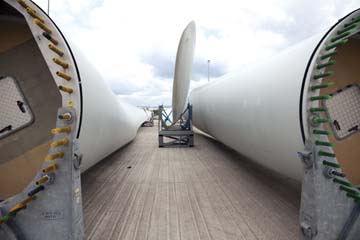
|
| 'Spatial spread of wind turbines over a large geographical area will mean that when wind is not blowing in one particular region, there are chances of wind blowing in another region.' |
Practically, however, even an aggregated lower value of variance could be high enough to make load management difficult. One more area of concern is the ramp up/ ramp down rate in wind generation, which is very high. Effectively managing the load for high ramp variation in wind generation will need an accurate advanced forecasting model or a firm generation source that can complement the ramp time characteristics of wind.
However, there are effective solutions to managing wind generation variability. Complementing wind generation with hydro, which has high ramp up ramp down time, is one of the solutions. For this, dedicated pumped hydro storage schemes are ideal ways to ‘store' a part of wind energy and later use it to complement variation in wind generation. Integrating wind and solar generation can be another solution as wind and solar generation usually complement each other over day and also across seasons. Forecasting is another technique which can help the grid operators in effective load management. A combination of all these technology options can surely address the issue and can help us to manage even a 50%+ wind grid effectively.
In this context, it is worth nothing the effective integration of wind energy in the Danish Grid. Denmark receives 28% of its grid electricity from wind and there are instances when the wind generation contribution goes as high as 42%. The Danish grid has been able to mange this penetration effectively. In fact, Danish government is planning to increase the wind contribution to 50% by 2020 and 100% by 2050.
(source:http://www.guardian.co.uk/environment/video/2012/apr/19/denmark-wind-power-video)
This proves that effective management can ensure that our homes remain powered even when the wind is not blowing.
What are the advantages of generating wind energy compared to other conventional modes?
a. Energy Security: Secure energy source. No dependence on limited resources (coal/gas/fuel, etc) or foreign fuel resources ( imported coal/oil)
b. Financial security: Free energy source. No effect of supply shocks unlike in the case of imported coal/oil etc where international prices can affect power generation costs
c. Climate friendly: Low lifecycle CO2 emissions as compared to any conventional technology
d. Environmentally benign: No pollution. No effluents. No pollution related local/global effects.
e. Low land use impact: Can be installed on footprint basis on farmland without diverting the whole of farmland. Wind turbines co-exist with farming.
f. Low auxiliary requirements: Zero water footprint as compared to huge freshwater requirements for conventional plants. No auxiliary requirements (fuel oil/diesel/heavy transport)
g. Low installation time: Can be installed in a span of 3-6 months as compared to conventional large plants that can take up to 3-8 years.
Can you briefly, tell us the environmental impacts of wind power?
The some of the documented environmental impacts of wind power mostly in
Western countries are;
- Loss of ecological diversity
- Bird hits
- Noise pollution
- Visual pollution
As a research institution, what changes you want to see in the policies and regulations of the government in promoting renewable energy?
Right now, the government policies and regulations are more focused on treating renewables as just one of the important new energy sector that has to be supported. Unless the policy makers and regulators understand that renewables are an imperative and not an option, policy and regulations will always be short of supporting the sector in an effective way.
We would like to see policies that give renewables their due. Some examples of policy changes that we support are priority sector lending status for renewables, enacting a separate Renewable Energy Law for India, introduction of more production based incentives, central/state incentives for RE infrastructure, separate RE units in all the important planning and coordinating agencies of central and state government in power sector.
On the regulatory front, we would support more aggressive RPO regulations and compliance mechanisms, rationalisation of open access charges across states and removal of hurdles in RE power evacuation and its planning and approvals.
How can wind turbine generated electricity make a difference in combating climate change?
For mitigation of climate change, major concern is to reduce GHG. Major component of GHG emission is due to power generation form conventional sources. If power generation through wind energy contributes major portion in overall power generation sector, GHG emission in the atmosphere will be reduced and thus, power generation from wind will complement the effort of climate change mitigation.
As an alternative energy, Wind energy has great potential and can be used to a large extent. What is the impediment in generating it worldwide?
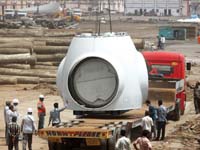 |
| Transportation of Windmill hub for installation |
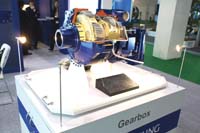 |
| Display of long-term supply contract for 2MW gearboxes for wind turbine systems |
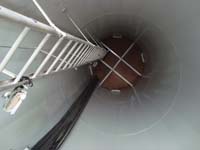 |
| Inside a windmill |
According to us there are only two challenges.
The biggest challenge is the acceptability of wind power. Power planners and policy makers attuned to conventional power are not able to accept and comprehend the immense benefits of wind energy. They look at a combination of conventional metrics ( weconomics and generation variability) and assume that wind energy is not viable. However, they forget the direct benefits of wind energy like energy security, financial security, climate friendliness, low environmental foot print are not being captured in the conventional metrics. This realisation has dawned only recently in some European countries who have now started looking at renewables as a necessity and not as an alternative option. Few EU countries have plans in place for higher RE power till 2050.
The second more manageable challenge is the cost of wind. There are commercial acceptance issues from utilities which have to pay preferential tariff for wind generation. However, it is to be noted that the preferential tariffs for many wind rich states like Gujarat, Tamil Nadu and Karnataka have not been revised for some years and the gap between the average power procurement cost (APPC) and the preferential tariffs for wind power has actually reduced over the years indicating that wind power is nearing the grid parity. Besides, recent experiences with UMMPs indicate that low thermal power generation costs cannot be taken for granted. It has to be accepted that wind power is getting competitive and will achieve grid parity in near future effectively discounting any need for cost comparison.
Can you tell us about the organisation's future plan (Programmes, Activities etc….)
The present bottlenecks we observed in development of the sector are lack of manufacturing & export incentives, need of modifying project financing mechanism, optimal land utilisation strategies, research & development support to the industry, off-shore wind potential mapping and project development framework, human resource needs and development, re-powering alternatives, power evacuation
and transmission planning, scheduling and forecasting of wind power, etc. Our institute is committed towards addressing all these shortcomings by creating new policy and regulatory initiatives with the help of wind power stakeholders.
SUZLON
Being headquartered in India, which are the potential places you feel where windmills can be installed?
The world has over 72 GW of wind energy potential. India alone has an installed base of over 16,000 MW from wind power and is recognised as the world's fifth largest wind market. Recent reports predict that wind can generate as much as 24 per cent of India's total power demand by 2030. Suzlon has wind farms across eight states in India, with over 1 GW of installations in Rajasthan, Gujarat, Maharashtra, Karnataka and Tamil Nadu - this is a clear indication of the vast available potential across India.
The market for wind energy has shown a constant progress in the last few years. What are the factors that have driven this growth?
Wind turbines are now typically 100 times more powerful than earlier versions and employ sophisticated materials, electronics, and aerodynamics. This has ensured a consistent lowering of costs, making wind more competitive than many other power generation options. Even amongst renewables, wind is approximately four times cheaper than solar.
The Government has been very focused and committed to building a low-carbon economy. It has enabled the growth of the renewable energy sector through various progressive policies. We have seen accelerating policy support at both State and Central government levels, with new guidelines for wind power tariff calculation and Renewable Energy Certificates (REC) trading mechanism. These have opened up opportunities for multiple revenue streams and incentive options, making the sector viable and profitable for investors.
Alongside other mechanisms, such as Accelerated Depreciation, GBI and preferential feed-in tariffs for electricity procured from renewable sources, India boasts a robust and mature green energy policy framework.
What is the estimated market worldwide in the wind turbine sector? Can you tell us the future importance it holds in global eco-friendly scenario?
There has been a steady increase in financing for new-build wind projects, and projections put the global pipeline of wind installations between 140 GW and 150 GW over the next three years. By 2020, this will add up to over 700 GW, supplying more than eight per cent of the world's electricity needs, creating more than one million jobs and saving more than 1,000 mt CO2 annually - the equivalent of planting more than 60 million trees.
Source:http://www.indianwindpower.com/pdf/GWEO_A4_2008_India_LowRes.pdf
Wind turbines have gone through major design modifications over the years; can you tell us the national and international standards when it comes to size and height of the turbine?
At the Suzlon Group we have turbines ranging from 600 kW to 6.15 MW - a product portfolio to meet all customer needs at every wind site. All Suzlon turbines meet and surpass national and international standards.
How competitive is wind power compared with conventional power generating expenditure wise?
Wind is already competing with conventional energy sources, such as natural gas, after seeing a reduction in costs to the tune of 25 per cent in the last three years.
As an alternative energy, Wind energy has great potential and can be used to a large extent. What is the impediment in generating it worldwide?
The wind market has been growing consistently over the past few years despite volatile economic conditions. There is still immense potential for further growth which can be facilitated through the effective implementation of a conducive policy framework and a strong infrastructure (land, power evacuation and logistics) backbone.
How can wind turbine generated electricity make a difference in combating climate change?
Wind power has potential to significantly reduce dependence on imported fuels and improve air quality. A single 1.67-MW turbine can produce over 5,000 MWh of electricity per year and reduce CO2 emissions by over 3,000 tons - equivalent to planting 85,514 trees. That means that the CO2 reduction by each average sized turbine is equivalent to taking approximately 500 cars off the road.
A report by The Climate Group estimates that, by 2050, emission savings from wind technologies would increase to 2.14 GtCO2 (4.5 per cent of overall energy-related emissions reduction or about 12 per cent of emissions savings in power sector).
Source: http://www.suzlon.com/lets-save-the-planet-book-by-tulsi-tanti
The perception towards wind energy has changed in India compared to last few years, which in turn has attracted more wind turbines manufacturers to this market? Can you explain?
As elaborated earlier, India is a unique market for wind and presents great opportunity for both suppliers and investors. Combined with our innovative end-to-end solution, state level offerings of unique ‘wheeling and banking' model, fiscal incentives such as accelerated depreciation and Generation Based Incentive (GBI) allows the creation of financially viable, scalable wind power solutions.
The potential for wind in India is tremendous and support by our visionary government will only further boost its growth. We believe that the Government's clear focus on energy security and climate change issues, and consistent and supportive policies will result in continuing strong growth of the Indian wind energy sector, and we will continue to play a key role in fulfilling it.
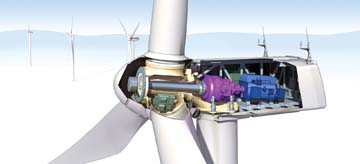 |
the wind industry, we have seen a marked shift towards emerging markets like India, China, South Africa, Mexicoand Brazil, which present enormous potential. |
At present, India is at the fifth position of wind power capacity. What is your take on that?
India's supportive renewable energy policies have ensured a mature wind market in India. We believe that the wind market in India will continue to grow strongly for years to come.
What are the recommendations you suggest in the policies or regulations of Indian government with regards to renewable energy?
Conducive policy framework and its effective implementation - The first part of policy formation is well on track with some progressive and reformative structural changes
introduced in form of CERC tariff guidelines, GBI scheme, REC mechanism etc. Now the bigger challenge is to effectively implement these policies to derive desired results.
Infrastructure (land, power evacuation and logistics) - This could be the serious concern in India's ambitious targets of raising the share of renewable to 15 per cent by 2020 under the Prime Minister's National Action Plan for Climate Change (NAPCC). A possible solution would be to encourage higher private participation in this development. Suzlon has so far, successfully demonstrated this by commissioning 73 sub-stations with cumulative capacity of over 5600 MVA and laid transmission lines of nearly 1,100 kms to facilitate development of wind power projects in various states of India.
Having made your mark all over the world, what is your key message to other countries like India?
In the wind industry, we have seen a marked shift towards emerging markets like India, China, South Africa, Mexico and Brazil, which present enormous potential. With Suzlon's extensive emerging market experience, we are well placed to compete strongly in this complex market landscape. Suzlon's investments in technology and R&D have unlocked margins by reducing the life cycle cost of wind energy, thus making wind energy affordable and desirable for emerging economies.
Reference :
http://http://www.inwea.org
http://www.wisein.org
http://www.indiawindenergysummit.co